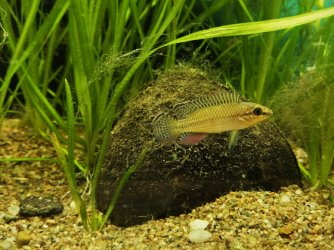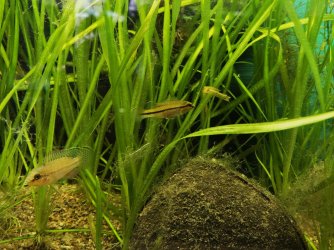This one has been hard to figure out, but I'm pleased to say I now have one pair, my original wild caughts guarding fry, and a second pair (F-1, the older pair's young grown up) guarding larvae for their second brood.
The fish were caught on a trip to Gabon Central Africa. I had one pair I brought back. I had to grow them to breeding size,and then go through four or five failed spawns before these excellent parents began to guide their fry around. I had 15 from that first spawn - 11 males, 3 females and 1 I still can't sort out in my head. It has attributes of both sexes.
I think my early difficulties related to too high temperatures.
My tap water comes from a forest lake with quite soft and acid water. The fish didn't like warm water above 23c, and bred at 22c, the temp they were caught at. The female took the majority of the brood care, and the male guarded the nest very very closely. As the female leads the brood out and they begin to feed, he stays just above, guarding as they move through the moss. The female often seems to stay close to the nest and leaves him to guide. The same pattern shows with the F-1 breeders.
I have no idea how I could get numbers of them into the hobby - I suspect the small broods and a ratio problem (most people who have gotten spawns have never gotten females from them, only males) dooms them to a marginal space in the hobby. But they are an interesting group - just one of a number of similar species found in the small creeks and streams of Central Africa.
The fish were caught on a trip to Gabon Central Africa. I had one pair I brought back. I had to grow them to breeding size,and then go through four or five failed spawns before these excellent parents began to guide their fry around. I had 15 from that first spawn - 11 males, 3 females and 1 I still can't sort out in my head. It has attributes of both sexes.
I think my early difficulties related to too high temperatures.
My tap water comes from a forest lake with quite soft and acid water. The fish didn't like warm water above 23c, and bred at 22c, the temp they were caught at. The female took the majority of the brood care, and the male guarded the nest very very closely. As the female leads the brood out and they begin to feed, he stays just above, guarding as they move through the moss. The female often seems to stay close to the nest and leaves him to guide. The same pattern shows with the F-1 breeders.
I have no idea how I could get numbers of them into the hobby - I suspect the small broods and a ratio problem (most people who have gotten spawns have never gotten females from them, only males) dooms them to a marginal space in the hobby. But they are an interesting group - just one of a number of similar species found in the small creeks and streams of Central Africa.
Attachments
Last edited:



